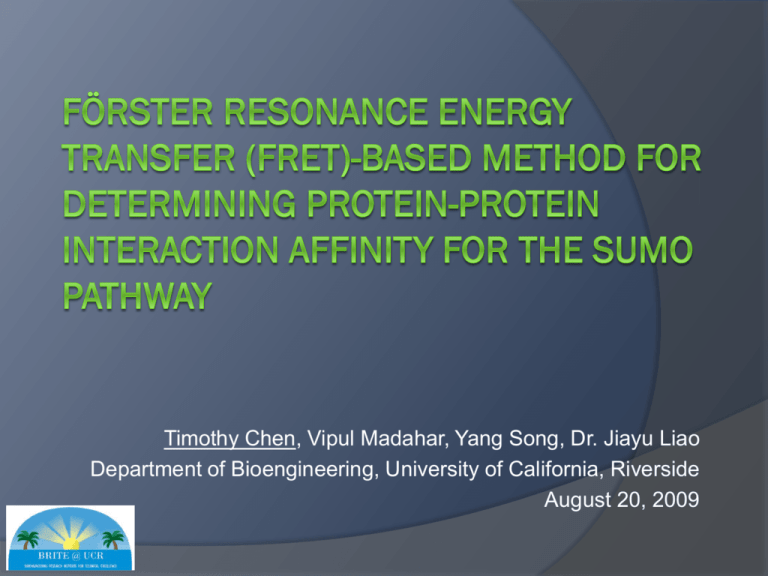Förster Resonance Energy Transfer (FRET)
advertisement

Timothy Chen, Vipul Madahar, Yang Song, Dr. Jiayu Liao Department of Bioengineering, University of California, Riverside August 20, 2009 Objective We wanted to calculate the dissociation constant, Kd, between proteins in the SUMO pathway using Förster Resonance Energy Transfer. Calculating Kd Kd is the dissociation constant SUMO1 + UBC9 ↔ SUMO1-UBC9 Kd = [SUMO1] [UBC9] [SUMO1-UBC9] Kd is the concentration at which half the protein is free, and half is bound Förster Resonance Energy Transfer (FRET) Based on the principles published by Theodore Förster in 19485 FRET involves the transfer of energy between oscillating dipoles of similar resonance frequency3 Transfer Effeciency, E E = (R0/r)j/[(R0/r)j + 1] R0, Förster Distance r, distance between the centers of the chromophores j, exponent of distance dependence FRET found to be r6 dependent 11 Förster Distance, R0 5 ĸ2, Dipole Orientation Factor Q0, Quantum Yield of the energy donor in the absence of energy transfer J, spectral overlap4 n, refractive index of the solvent Dipole Orientation Factor, ĸ2 Ranges from 0 to 4 Typically assumed to be 2/3 when both molecules can freely diffuse in solution5 FRET 1. 2. 3. 4. Donor has a high quantum yield There is substantial spectral overlap The dipoles of the donor and acceptor can align properly The donor and acceptor are at a proper distance2 Why use FRET? FRET occurs over biologically relevant distances (1-10nm)10 No Binding: SUMO1 Binding: 414nm CYPET 414nm CYPET SUMO1 UBC9 YPET 475nm UBC9 YPET 530nm Small quantities can be used Concentrations can be accurately determined7 No radioactive materials are required Can be developed into an in vivo method1 cDNA cloning Sal1 Not1 Nhe1 Sal1 Not1 Nhe1 Sal1 Not1 HIS PCR2.0 PCR2.0 UBC9/SUMO1 CYPET/YPETSUMO1/UBC9 PET28B CYPET/YPETSUMO1/UBC9 Protein Expression and Purification Isopropyl β-D-1thiogalactopyranoside used to induce expression Purification using Ni2+NTA affinity chromatography and High Performance Liquid Chromatography Proteins stored at -800C in 20mM NaCl, 50mM Tris-HCl pH 7.4, and 5mM Dithiothreitol7 Concentrations determined using a Bradford Protein Assay Multi-well Plate Assay Measurements done in spectrofluorometer using bottom excitation and collection Used Falcon 384-well black, clear bottom plates YPET-UBC9 dispensed in triplicate from concentrations of 0.0 μM – 7.5 μM Wells topped off with either 4μM CYPET+UBC9, 4μM CYPET, or buffer7 Proof of Concept Increasing YPET-UBC9 concentration from 0.0 μM – 5.0 μM CYPET-SUMO1 concentration remains constant at 1.0 μM Increasing YPET-UBC9 1000000 Emssion [a.u.] 800000 600000 400000 200000 0 450 470 490 510 530 wavelength [nm] 550 FRET Data Fluorescence emission at 530nm of the multi-well plate assay CYPET-SUMO1+YPET-UBC9 CYPET+YPET-UBC9 Buffer+YPET-UBC9 530nm Emission [a.u.] 1200000 1000000 800000 600000 400000 200000 0 0.0 0.5 1.0 1.5 2.0 2.5 3.0 3.5 4.0 4.5 5.0 5.5 6.0 6.5 7.0 7.5 8.0 YPET-UBC9 [μM] Steady-State FRET FRET Data after subtraction of CYPET+YPET-UBC9 control data 530nm Emission [a.u.] 800000 700000 600000 500000 400000 300000 200000 100000 0 0.0 1.0 2.0 3.0 4.0 5.0 YPET-UBC9 [μM] 6.0 7.0 8.0 Calculating Kd Saturation level corresponds to 1.0 μM CYPETSUMO1 bound Converted Fluorescence signal into bound protein concentration Plot of Bound Protein versus Free Protein Bound Protein [μM] 0.8 0.6 0.4 [BP] = Bmax [FP] Kd + [FP] 0.2 0 0 Fitted with binding hyperbola for one binding site using MATLAB’s curve fitting tool8 Kd was calculated to be .088 μM +/- .029 μM 1 1 2 3 4 5 6 Free YPET-UBC9 [μM] Conclusion Our Kd = .088 μM +/- .029 μM The previous publication’s FRET experiment calculated Kd = .59 μM +/- .09 μM. (Martin, 2008)7 Isothermal Calorimetry (ITC) calculated Kd = .082 μM +/- .023 μM (Puck, 2007)9 Future Work Determine Kd using BIACORE Calculating Kd in vivo1 Calculating Kd with inhibitors References 1. 2. 3. 4. 5. 6. 7. 8. 9. 10. 11. 12. Chen, Huanmian, Henry L. Puhl III, and Stephen R. Ikeda. "Estimating protein-protein interaction affinity in living cells using quantitative Forster resonance energy transfer measurements." Journal of Biomedical Optics 12 (2007): 054011. Print. Dos Remedios, Cristobal G., and Pierre D.J. Moens. "Fluorescence Resonance Energy Transfer Spectroscopy Is a Reliable "Ruler" for Measuring Structural Changes in Proteins." Journal of Structural Biology 115 (1995): 175-85. Print. "FRET Introductory Concepts." Olympus FluoView Resource Center. Web. 31 July 2009. <http://www.olympusfluoview.com/applications/fretintro.html>. Haughland, Richard P., Juan Yguerabide, and Lubert Stryer. "DEPENDENCE OF THE KINETICS OF SINGLET-SINGLET ENERGY TRANSFER ON SPECTRAL OVERLAP." Chemistry 63 (1969): 23-30. Print. Lakowicz, Joseph R. Principles of Fluorescence Spectroscopy. 3rd ed. New York: Springer, 2006. Print. Liu, Q., C. Jin, X. Liao, Z. Shen, D. Chen, and Y. Chen. "The binding interface between an E2 (Ubc9) and a ubiquitin homologue (UBL1)." J. Biol. Chem. 274 (1999): 16979-6987. Print. Martin, Sarah F., Michael H. Tatham, Ronald T. Hay, and Ifor D.W. Samuel. "Quantitavtive analysis of multi-protein interactions using FRET: Application to the SUMO pathway." Protein Science 17 (2008): 777-84. Print. Motulski, H. J., and A. Christopoulos. "Fitting models to biological data using linear and nonlinear regression: A practical guide to curve fitting." GraphPad Software, Inc., San Diego, CA. Print. Puck, Knipscheer, Vsn Dijk J. Willem, Olsen V. Jesper, Mann Matthias, and Sixma K. Titia. "Noncovalent interaction between Ubc9 and SUMO promotes SUMO chain formation." EMBO 26.11 (2007): 2797-807. Print. Sapsford, Kim E., Lorenzo Berti, and Igor L. Medintz. "Materials for Fluorescence Resonance Energy Transfer Analysis: Beyond Traditional Donor-Acceptor Combinations." Angew. Chem. 45 (2006): 4562-588. Print. Stryer, Lubert. "FLUORESCENCE ENERGY TRANSFER AS A SPECTROSCOPIC RULER." Ann. Rev. Biochem. 47 (1978): 819-46. Print. Stryer, Lubert, and Richard P. Haughland. "ENERGY TRANSFER: A SPECTROSCOPIC RULER." Biochemistry 58 (1967): 719-26. Print. Acknowledgements Special Thanks to Jun Wang, Dr. Victor Rodgers, Denise Sanders, Hong Xu, Harbani Malik, Yan Liu, Farouk Bruce, Sylvia Chu, Yongfeng Zhou, Monica Amin, Steven Bach, Richard Lauhead, Randall Mello, the Bioengineering Research Institute for Technological Excellence, and the National Science Foundation

